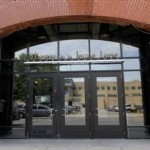[contextly_auto_sidebar id=”HUGScEGqXpFlTgmFU2f6jVTqnbt4ymzt”]
 There is an arts story that has been nagging at me the past couple months. It’s the recent announcement of the revised plans for the NYC Performing Arts Center planned for the former World Trade Center site.
There is an arts story that has been nagging at me the past couple months. It’s the recent announcement of the revised plans for the NYC Performing Arts Center planned for the former World Trade Center site.
The plan for an arts center at Ground Zero began more than ten years ago. At first the center was to house four arts organizations but three of the four were tapped out several years ago. Only one (the Joyce Theater) still remained as of last year. The project has never really gotten off the ground and plans have changed so many times I couldn’t begin to recount them all. The February announcement basically conveyed that things are changing again: a temporary artistic director (David Lan from the Young Vic in England) has been hired; rather than creating a dance center the new plan is to create a music, theater, and dance center on the model of the Young Vic, but more ambitious; the estimated costs of the project are unknown (though previously were projected between $300 and $700 million); it seems the lack of clarity about the budget may be related to the fact that the architectural design by Frank Gehry may need to be ditched because it was created when the plans for the project were still hazy (hmmm, that’s an expensive mistake); Gehry himself didn’t seem to be aware of this, though, since no one involved with the project had spoken to him in months; and the Joyce Theater may or may not have a future programming role, depending on who you ask.
The situation at the WTC PAC is frustrating and disheartening on multiple levels. I respect many of the people involved, so this is not a concern about individuals or their capacities as directors. Specifically, it’s not about a British director rather than an American being hired for the project (although given the symbolic significance of this project, I am surprised they did not hire someone from New York). And it’s not about whether or not a multi-disciplinary space with three small theaters and a cafe is better than a dance space with 1,000 seats and classrooms, or any of the other plans for the PAC site that have been presented over the years.
It’s about the time for this project having come and gone.
It’s about organizers having, long ago, lost the plot.
More than anything, it’s about having used up all of the do-overs a single entity can reasonably ask of its community.
Not that the community was ever consulted.
Here are my questions:
- Who still wants this space? Whose interests does it/will it serve? And given the numerous changes should the citizens of NYC have the opportunity to voice their thoughts on whether this project should still go forward?
- What role will it fill in the cultural landscape that is not already being more than adequately filled by other (potentially under-capitalized) organizations? As the article rightly points out the landscape has changed dramatically in the past ten years and there are spaces now available–Park Avenue Armory, the new TFANA space in Brooklyn, the Lincoln Center theater that was previously housing NYCO–that were not available when the PAC was first being planned.
- How much has been spent on this project over the past ten years? And on what? Should the public be given an accounting of all the private, tax deductible contributions and government funds that have been received and expended to date?
- Is the center the best use of half a billion dollars, or however much it will cost, given other options? And after raising the money to build it, how will it be sustained–particularly if it has a programming strategy modeled on the Young Vic (which seems to be suggested in the article). +
- Finally, why has this project had such an extraordinarily difficult time getting off the ground? Shouldn’t this be understood and addressed before additional resources are invested?
On Buckminster Fuller and Structural Integrity
About a month ago, I was reading about Buckminster Fuller and came across a concept that he applied in both his work as an engineer (designing the geodesic dome) and also in his quest as an “ordinary human being†trying to have positive influence in the world. It is the performance characteristic called structural integrity. From an engineer’s perspective structural integrity refers to the ability of a given structure to withstand a designed load under anticipated conditions. In a more metaphorical sense, Fuller used the term structural integrity to refer to a person’s accountability (to the ability to be counted on to do what one has said one will do).
Further describing Fuller’s take on integrity in his 2011 book, A Fuller View, L. Steven Sieden writes:
Bucky’s definition of integrity is structural. Anything that has integrity holds its shape regardless of external circumstances.
In the same book, Jim Reger and David Irvine also reflect on Fuller’s concept of structural integrity, and how it relates to leadership:
Integrity comes from the word “integer,†which means wholeness, integration, and completeness. Being integrated is a necessary condition for self-respect, and self-respect is the basis for creating a respectful environment. Integrity means having clear, explicit principles and doing what you say you’re going to do. It’s about being honest with yourself and others.
After reading these essays on Fuller I began thinking about two things.
The first was about accountability and how this manifests in organizations with no owners. Do nonprofit arts organizations feel accountable to the public? I’m not sure they do. When civic leaders and other community members pleaded for an end to the Minnesota Orchestra lockout, which was harming the local culture, did MSO, Inc. (i.e., the board and leadership) feel accountable to end the lockout and make good on its mission to “enrich, inspire and serve its community” by producing the concerts it had promised (and accepted tax-deductible funds to produce)?  It certainly didn’t look like it from the outside. The musicians did play concerts, however–and the community, unsurprisingly, largely stood behind them. More recently, San Diego Opera didn’t seem to feel the need to keep its community informed about its apparently rapidly deteriorating finances. A couple weeks ago it sent out a puzzling announcement about plans to shut down–a decision that seems to have taken its community by surprise and to have raised hackles, particularly given that everyone had been led to believe that the opera company was doing quite well. Arts organizations talk about accountability to the public; but do they feel it?
The second thing I began to think about after reading a bit on Fuller’s concept of structural integrity centered around the causes of structural failure in nonprofit cultural organizations. When organizations or projects collapse there is a tendency to scrutinize the actions of the current cast of characters and the financial and programming decisions made in recent years; but perhaps in nonprofits–perhaps in cultural nonprofits in particular–the fatal mistakes are the ones we don’t tend to flag … because they don’t hit the P&L statement and the box office totals in the short term.
Perhaps they’re the ones that destroy something more essential to a cultural organization.
Its soul.
Its relationship to its artists and its community.
Its integrity.
The quiet harms that are done to those nonprofits exist to support and serve–the neglect, the taking for granted, the opportunism–may take time to fully register. But when they do, perhaps there is no going back and fixing the damage that has been done.
***
I don’t know when it happened, or how, but (from where I sit) the PAC at the World Trade Center site long ago lost its structural integrity. Or perhaps it never had any? I don’t know. The question now is, can this ever-collapsing structure be turned into something beautiful for the city of New York and the rest of the world, or would it be best to let this cursed project go and allow for the possibility of something entirely new to be created from the ground up.
+According to an annual report from 2006 that I located, the Young Vic cost 12.5 million (gbp) to build and its annual turnover was around 3.6 million in 2006, about half of which was funded from the government. It still receives about 1.75 million per year.
Â
Â




